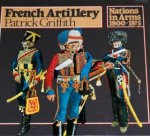
French Artillery
Patrick Griffith
48 pages
published in 1976
I know it's slightly embarassing to like this sort of book, the war nerd equivalent of some AD&D monster handbook, but I can't help it. I have always been interested in military history and warfare and still am. Warfare, like it or not, is an important part of our history and we cannot understand our current situation if we stay ignorant of military history. Noble words, but not very convincing in this case, as French Artillery is not the kind of book anyone needs to read to understand the history of Europe...
The title is somewhat misleading; French Artillery is part of the Nations in Arms 1800-1815 series; its emphasis is on the artillery of the Napoleonic Era and then mostly at what these soldiers looked like. Plenty of large colour plates make up a signficant part of its page count. The history of the French artillery during this period is only sketched in.
Which does not mean French Artillery is useless. Sketchy as it is, it is still a nice look at a period in military warfare with which I'm not that familiar. I don't know about you, but I find it easy to think warfare before the 20th century only changed slowly and was much the same from year to year. This book made it clear that in the artillery's tactics, strategy and equipment at least, there was a rapid evolution happening in the early 19th century.
This evolution was the use of artillery in mass quantities: no longer single guns or even batteries in a supporting role, but massed amounts of guns, in some cases a hundred or more, as the decisive factor of a battle. In this new role the artillery was transformed from a largely static weapon into a mobile one which could pursue the enemy in the same way the cavalry or infantry had been able to do for centuries.
This development was made possible by the reforms of Gribeauval, who was responsible for standardising and redesigning French artillery equipment after the Seven Years War (1756-1763). Gribeauval cut down on the weight of the guns, improved their mobility and ease of use, standarised the designs and calibres used and finally improved the artillery's accuracy by using better ammunition and aiming mechanisms.
These redesigns and improvements laid the foundation for the further development of the French artillery. Whereas the artillery had mostly operated on a brigade level, the Revolutionary and Napoleonic wars saw the ever greater massing of artillery pieces, sometimes a hundred guns together. With such numbers it was possible for the artillery to hold the line or mount an attack all by itself, though this was still comparatively rare. French artillery gives as an example of these tactics the battle of Friedland.
French Artillery is lavishly illustrated, mainly with examples of the uniforms the various different artillery soldiers wore. Myself, I would've liked to see more examples of the actual equipment rather than the uniforms. There are too few examples in the chapter on the equipment to make clear what is being talked about.
